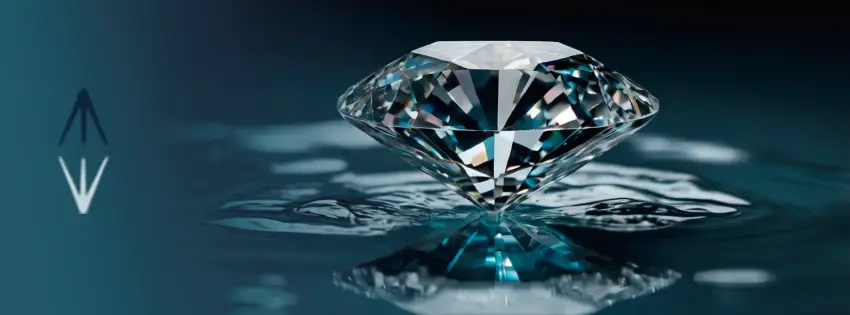– Diamonds are known for their brilliance, hardness, and exclusivity, but there is a lesser-mentioned property that plays a crucial role in their identification and valuation: density. This physical characteristic distinguishes diamonds from other gemstones and imitations, allowing gemologists and experts to verify their authenticity.
In this article, we will explore what diamond density is, how it is measured, and why it is a key factor in gemology.
1. What Is Density and How Does It Apply to Diamonds?
Density is a physical property that measures the amount of mass contained in a given volume. It is expressed in grams per cubic centimeter (g/cm³) and varies depending on the type of material.
For diamonds, the average density is 3.52 g/cm³, meaning that a diamond is 3.52 times denser than water. This value is constant in natural diamonds, making it a key reference for identifying this precious stone.
2. How Is Diamond Density Measured?
Gemologists use two main methods to measure a diamond’s density:
🔹 2.1. Hydrostatic Balance (Archimedes’ Principle)
This method is based on the weight difference of a diamond in air and water:
1️⃣ The diamond is weighed on a precision scale.
2️⃣ It is then weighed again while submerged in water.
3️⃣ Using the weight difference and applying the density formula (mass/volume), the exact value is obtained.
📌 Example: If a diamond weighs 1.76 g in air and 0.50 g less in water, its density is calculated as follows:
📏 Density = 1.76 g / 0.50 cm³ = 3.52 g/cm³
If the result is 3.52 g/cm³, we can be sure that it is an authentic diamond.
🔹 2.2. Dense Liquids
This method involves submerging the diamond in liquids of known density:
✅ If the diamond floats, its density is lower than that of the liquid.
✅ If the diamond sinks, its density is higher.
✅ If it remains suspended, its density is similar to that of the liquid.
This process allows for comparing a diamond’s density with other gemstones without causing any damage.
3. Comparison of Diamond Density with Other Gemstones
Diamond density falls within an intermediate range compared to other precious stones. The following table shows some of the most common gemstones and their densities:
| Gemstone | Density (g/cm³) |
|---|---|
| Diamond | 3.52 |
| Moissanite | 3.21 |
| Sapphire | 3.95 – 4.03 |
| Ruby | 3.97 – 4.05 |
| Emerald | 2.67 – 2.78 |
| Quartz | 2.65 |
🔎 Key Fact: Moissanite, one of the most common diamond imitations, has a lower density (3.21 g/cm³), making this method an excellent tool for distinguishing between the two gemstones.
4. Importance of Density in Diamond Identification
Density is an essential property in gemology because it allows experts to:
✅ Distinguish authentic diamonds from imitations.
✅ Determine the type of diamond (some varieties may have slightly different densities).
✅ Verify the presence of impurities or inclusions, which can affect the stone’s value.
Additionally, in the world of gemstone investments, density is used to ensure the authenticity of diamonds acquired at auctions or international markets.
5. What Factors Can Affect a Diamond’s Density?
While diamond density is typically constant at 3.52 g/cm³, some factors can cause slight variations:
✔ Impurities and traces of chemical elements: Diamonds with inclusions may have slightly different densities.
✔ Diamond varieties: Some natural diamonds may contain small differences in chemical composition.
✔ Treatments and alterations: If a diamond has been treated or modified, its density could be affected.
However, these variations are minimal and do not compromise the reliability of density as an identification method.
6. Conclusion: Why Is Diamond Density Important?
💎 Density is one of the most useful properties for identifying diamonds.
📏 With a value of 3.52 g/cm³, it helps differentiate diamonds from other gemstones and imitations.
🔬 Its measurement is key in gemology to verify a diamond’s authenticity and purity.
Whether you’re a collector, investor, or simply a gemstone enthusiast, understanding diamond density will help you ensure that your stone is genuine and of high quality.
7. Frequently Asked Questions About Diamond Density
1️⃣ How can I tell if a diamond is real using its density?
You can use a hydrostatic balance to calculate its density. If the result is 3.52 g/cm³, the diamond is authentic.
2️⃣ Do synthetic diamonds have the same density as natural ones?
Yes, lab-grown diamonds have a density almost identical to natural ones, so this method is not useful for distinguishing them.
3️⃣ Why is a diamond’s density different from other gemstones?
Because its pure carbon crystalline structure is more compact than that of other stones like quartz or emerald.
4️⃣ Can a diamond’s density change over time?
No, a diamond’s density remains stable over time, unless it has been artificially modified or treated.




